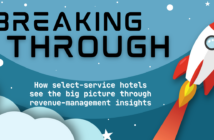by MARK SKROCH
To say that the past year has been difficult for the hotel industry would be an understatement with COVID-19 and the associated travel restrictions resulting in a dismal 2020 for hotel bookings globally. Things are starting to look up with traveler confidence beginning to rise, and more people thinking about travel in the coming year. According to Destination Analysts, 23.1 percent of American travelers have taken a trip by air during the pandemic, and 58.1 percent have taken a road trip. Nearly 80 percent have at least tentative trip plans for some time in the next year.
Our research at BCV, a company provicing social media solutions for the hospitality industry, shows social media inquiries to hotels have increased by 44 percent in August 2020 vs. August 2019, with many of the questions surrounding outdoor activities, COVID-19 restrictions, Wi-Fi capabilities, and hotel cleaning practices – essentially all that comprises the “new normal.” This increase in social media communication comes as the current and near future COVID-19 travelers appear to be falling into a number of categories: staycationers, bargain hunters, and bucket listers, with each group having a series of wants that hotels can target.
STAYCATIONERS
Staycationers are tired of being at home, but they do not want to risk long-distance travel. They may want to visit family or friends locally or just explore parts of their home region. They also are motivated by work-from-home and remote-schooling trends that allow them to stay for a longer period. These vacationers are most interested in hotel COVID-19 measures, having great Wi-Fi connectivity, and information on local, outdoor entertainment. Staycationers typically travel by car and do not mind longer drives for the right destination. They are interested in having the right dates and prioritize the dates over price considerations. In addition, staycationers will be interested in starting new traditions closer to home during the upcoming holiday seasons.
BARGAIN HUNTERS
Bargain hunters are motivated by obvious cost incentives and they have more comfort in taking risks in terms of traveling farther distances, traveling by plane, etc. What will attract these customers is the chance to stay in a hotel or a room that would normally be outside of their price point during normal travel times. Bargain hunters cut across different demographics. The younger members of Gen Y and the older members of Gen Z are two groups that are motivated by price, willing to undertake some risk in travel, and able to travel distances with the current remote work/learning capabilities.
BUCKET LISTERS
Bucket listers, the final category, have a different reaction than most to the restrictions from the pandemic. They are reminded of the temporal nature of life and that they cannot be guaranteed time for their planned adventures. They are motivated by the desire to see these exotic destinations and by the fact that the locations will likely not have the typical crowds. Having this travel experience without the typical crowds or wait time will be the primary motivators for this group.
REACHING OUT
The key to reaching these three types of travelers lies in social media and in knowing which platforms your audiences are on. Of the different platforms, Instagram continues to be the primary vehicle for travel research, as it has been for several years. There also are almost continuous rollouts of new Instagram tools to appeal to the shifting consumer mindset – such as short-form video feature reels – as well as the growing suite of marketing capabilities on Instagram, such as the “Shop Now” feature, which allows hotels to add booking capabilities to their stories. For each of the types of travelers listed above, Instagram can showcase what they are looking for in a getaway. For staycationers, content that reflects the hotel amenities as well as local attractions will resonate. For bargain hunters, content that shows the amount of savings as well as more luxurious surroundings for lower prices will be good. For the bucket listers, content that shows the once-in-a-lifetime aspects along with the absence of traditional crowds will appeal to these travelers.
Another way that hotels can gain the attention of these three types of travelers as well as stay connected with past guests is to create custom content that would attract different audiences. To note, different platforms should be used for specific audiences, and that platform/audience mix will depend on the hotel’s primary demographic. Also, using a solid social channel mix will allow hotels to target users at multiple points of their journey. With that said, almost all social media users prefer short-form videos and it remains the most popular form of content.
TAP INFLUENCERS
Hotels should also build relationships with the two main types of influencers: multichannel and micro-influencers. Both types need to be community-focused and authentic, so the messaging remains true to the brand. Multichannel influencers can enable multiple connection points with consumers, helping to seed messaging at various points of the consumer journey and offering a deeper value for the partnership. For example, a user may consume the branded message via an influencer’s social post, podcast chat, and direct e-blast in one day, helping to drive overall awareness and consideration. A micro-influencer is one with 10,000 followers or fewer and who can create a more personal connection to resonate with a social user. This personal connection is something that consumers are placing an importance on as they plan future travel.
The recovery will take time and will be multifaceted, but those hotels that invest in a social media strategy looking for different types of customers will emerge in a stronger position.
 Mark Skroch is the General Manager at BCV, a RateGain company. To learn more, visit https://www.bcvsocial.com/.
Mark Skroch is the General Manager at BCV, a RateGain company. To learn more, visit https://www.bcvsocial.com/.




